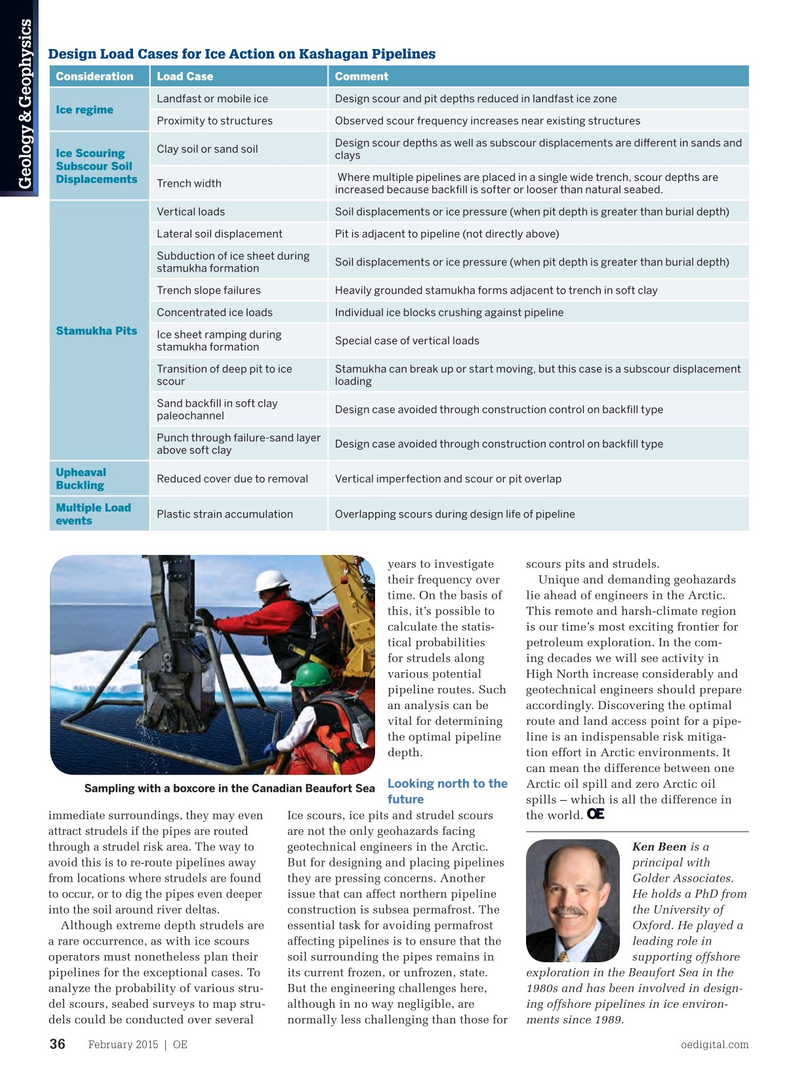
Page 34: of Offshore Engineer Magazine (Feb/Mar 2015)
Read this page in Pdf, Flash or Html5 edition of Feb/Mar 2015 Offshore Engineer Magazine
Design Load Cases for Ice Action on Kashagan Pipelines
Consideration Load Case Comment
Landfast or mobile ice Design scour and pit depths reduced in landfast ice zone
Ice regime
Proximity to structures Observed scour frequency increases near existing structures
Design scour depths as well as subscour displacements are diferent in sands and
Clay soil or sand soil
Ice Scouring clays
Subscour Soil Where multiple pipelines are placed in a single wide trench, scour depths are
Displacements
Trench width
Geology & Geophysics increased because backfll is softer or looser than natural seabed.
Vertical loads Soil displacements or ice pressure (when pit depth is greater than burial depth)
Lateral soil displacement Pit is adjacent to pipeline (not directly above)
Subduction of ice sheet during
Soil displacements or ice pressure (when pit depth is greater than burial depth) stamukha formation
Trench slope failures Heavily grounded stamukha forms adjacent to trench in soft clay
Concentrated ice loads Individual ice blocks crushing against pipeline
Stamukha Pits
Ice sheet ramping during
Special case of vertical loads stamukha formation
Transition of deep pit to ice Stamukha can break up or start moving, but this case is a subscour displacement scour loading
Sand backfll in soft clay
Design case avoided through construction control on backfll type paleochannel
Punch through failure-sand layer
Design case avoided through construction control on backfll type above soft clay
Upheaval
Reduced cover due to removal Vertical imperfection and scour or pit overlap
Buckling
Multiple Load
Plastic strain accumulation Overlapping scours during design life of pipeline events years to investigate scours pits and strudels.
Unique and demanding geohazards their frequency over lie ahead of engineers in the Arctic. time. On the basis of
This remote and harsh-climate region this, it’s possible to is our time’s most exciting frontier for calculate the statis- petroleum exploration. In the com- tical probabilities ing decades we will see activity in for strudels along various potential
High North increase considerably and geotechnical engineers should prepare pipeline routes. Such accordingly. Discovering the optimal an analysis can be route and land access point for a pipe- vital for determining line is an indispensable risk mitiga- the optimal pipeline tion effort in Arctic environments. It depth.
can mean the difference between one
Looking north to the
Arctic oil spill and zero Arctic oil
Sampling with a boxcore in the Canadian Beaufort Sea future spills – which is all the difference in immediate surroundings, they may even Ice scours, ice pits and strudel scours the world. are not the only geohazards facing attract strudels if the pipes are routed through a strudel risk area. The way to geotechnical engineers in the Arctic. Ken Been is a avoid this is to re-route pipelines away
But for designing and placing pipelines principal with from locations where strudels are found they are pressing concerns. Another Golder Associates. issue that can affect northern pipeline He holds a PhD from to occur, or to dig the pipes even deeper construction is subsea permafrost. The the University of into the soil around river deltas.
Although extreme depth strudels are essential task for avoiding permafrost Oxford. He played a a rare occurrence, as with ice scours affecting pipelines is to ensure that the leading role in operators must nonetheless plan their soil surrounding the pipes remains in supporting offshore pipelines for the exceptional cases. To its current frozen, or unfrozen, state. exploration in the Beaufort Sea in the analyze the probability of various stru-
But the engineering challenges here, 1980s and has been involved in design- del scours, seabed surveys to map stru- although in no way negligible, are ing offshore pipelines in ice environ- dels could be conducted over several normally less challenging than those for ments since 1989.
February 2015 | OE oedigital.com 36 034_0215OE_G&G1_Golder.indd 36 1/20/15 6:17 PM

 33
33

 35
35